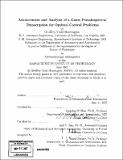| dc.contributor.advisor | Jonathan P. How and Anil V. Rao. | en_US |
| dc.contributor.author | Huntington, Geoffrey Todd, 1979- | en_US |
| dc.contributor.other | Massachusetts Institute of Technology. Dept. of Aeronautics and Astronautics. | en_US |
| dc.date.accessioned | 2008-09-03T14:49:26Z | |
| dc.date.available | 2008-09-03T14:49:26Z | |
| dc.date.copyright | 2007 | en_US |
| dc.date.issued | 2007 | en_US |
| dc.identifier.uri | http://hdl.handle.net/1721.1/42180 | |
| dc.description | Thesis (Ph. D.)--Massachusetts Institute of Technology, Dept. of Aeronautics and Astronautics, 2007. | en_US |
| dc.description | Includes bibliographical references (p. 195-207). | en_US |
| dc.description.abstract | As optimal control problems become increasingly complex, innovative numerical methods are needed to solve them. Direct transcription methods, and in particular, methods involving orthogonal collocation have become quite popular in several field areas due to their high accuracy in approximating non-analytic solutions with relatively few discretization points. Several of these methods, known as pseudospectral methods in the aerospace engineering community, have also established costate estimation procedures which can be used to verify the optimality of the resulting solution. This work examines three of these pseudospectral methods in detail, specifically the Legendre, Gauss, and Radau pseudospectral methods, in order to assess their accuracy, efficiency, and applicability to optimal control problems of varying complexity. Emphasis is placed on improving the Gauss pseudospectral method, where advancements to the method include a revised pseudospectral transcription for problems with path constraints and differential dynamic constraints, a new algorithm for the computation of the control at the boundaries, and an analysis of a local versus global implementation of the method. The Gauss pseudospectral method is then applied to solve current problems in the area of tetrahedral spacecraft formation flying. These optimal control problems involve multiple finite-burn maneuvers, nonlinear dynamics, and nonlinear inequality path constraints that depend on both the relative and inertial positions of all four spacecraft. Contributions of this thesis include an improved numerical method for solving optimal control problems, an analysis and numerical comparison of several other competitive direct methods, and a greater understanding of the relative motion of tetrahedral formation flight. | en_US |
| dc.description.statementofresponsibility | by Geoffrey Todd Huntington. | en_US |
| dc.format.extent | 207 p. | en_US |
| dc.language.iso | eng | en_US |
| dc.publisher | Massachusetts Institute of Technology | en_US |
| dc.rights | M.I.T. theses are protected by
copyright. They may be viewed from this source for any purpose, but
reproduction or distribution in any format is prohibited without written
permission. See provided URL for inquiries about permission. | en_US |
| dc.rights.uri | http://dspace.mit.edu/handle/1721.1/7582 | en_US |
| dc.subject | Aeronautics and Astronautics. | en_US |
| dc.title | Advancement and analysis of Gauss pseudospectral transcription for optimal control problems | en_US |
| dc.type | Thesis | en_US |
| dc.description.degree | Ph.D. | en_US |
| dc.contributor.department | Massachusetts Institute of Technology. Department of Aeronautics and Astronautics | |
| dc.identifier.oclc | 228876299 | en_US |
